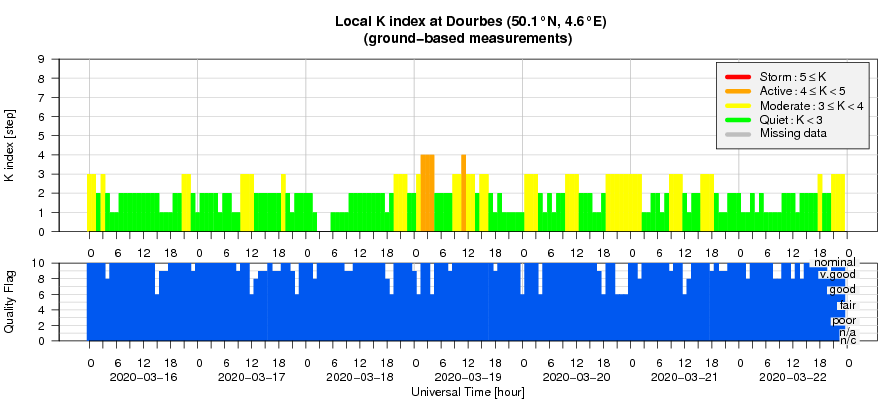- Table of Content
- 1.The best of......
- 2.EUI on hold
- 3.Review of sola...
- 4.The SIDC space...
- 5.PROBA2 Observa...
- 6.The Internatio...
- 7.Geomagnetic Ob...
- 8.Review of iono...
2. EUI on hold
3. Review of solar and geomagnetic activity
4. The SIDC space weather Briefing
5. PROBA2 Observations (16 Mar 2020 - 22 Mar 2020)
6. The International Sunspot Number by SILSO
7. Geomagnetic Observations at Dourbes (16 Mar 2020 - 22 Mar 2020)
8. Review of ionospheric activity (16 Mar 2020 - 22 Mar 2020)
The best of... 2019!
A compilation of the most memorable space weather moments of 2019 can be found at the STCE's dedicated Solar Cycle 24 page: http://www.stce.be/highlights
Using the versatile (J)Helioviewer software (http://www.jhelioviewer.org/ ), a ***MOVIE*** was created containing one or more clips of each event. Mostly SDO-images were used, occasionally supplemented with imagery from PROBA2, SOHO, and STEREO.
The movie can be found at https://www.youtube.com/watch?v=OiodSXJdG5I , whereas the page with the accompanying information is at http://www.stce.be/news/474/welcome.html
We wish you a happy viewing!
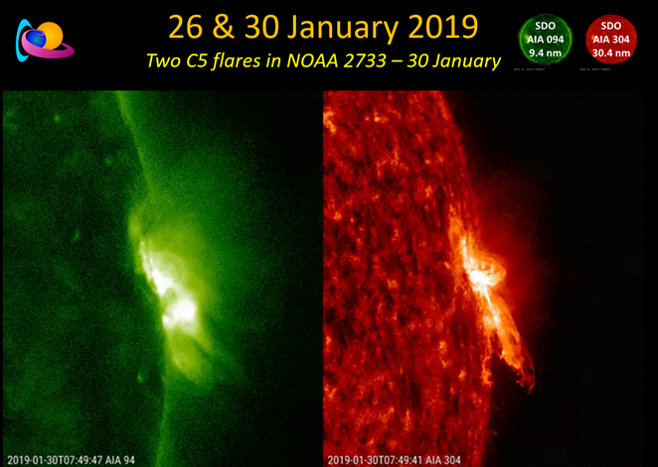
EUI on hold
The following message reached us: 'In view of the evolution of the Covid-19 spread and impact, with the purpose of firstly ensuring the health of our colleagues, but also securing access to the ESOC facilities to perform critical activities on ESA-operated spacecraft, the Solar Orbiter in-orbit commissioning has been put on hold.'
Health of people is now the first concern. This measure brings also an advantage for EUI. During launch, water and atmospheric particles can condense and stay glued on the spacecraft and on sensitive areas of instruments, creating a ‘misty window’ effect. It is crucial that the EUI telescope doors are opened only if the spacecraft has outgassed sufficiently and the mist has disappeared.
EUI will have a lot of outgassing time. And the EUI team will be more than ready when the commissioning starts up again.
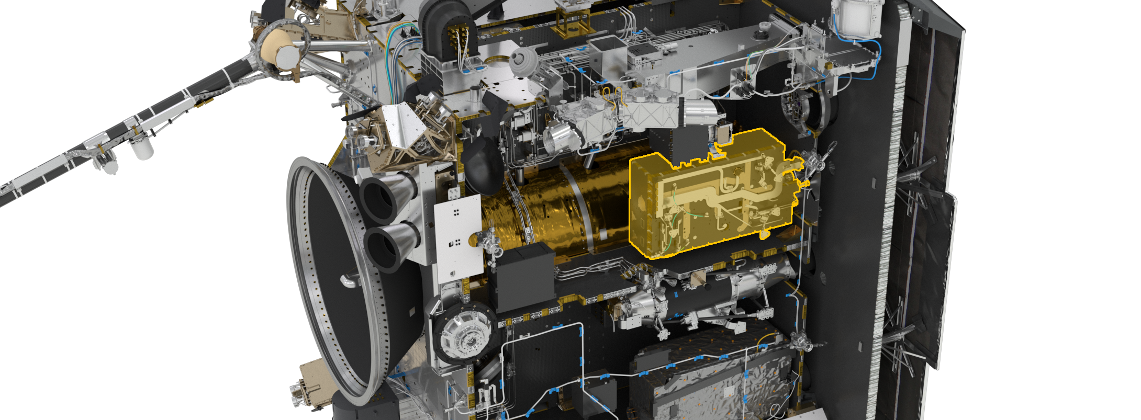
A few facts, on 22/03, Solar Orbiter was at:
- 18 million km from the Earth (0.12 AU); the one-way signal travel time was 1 min 00 sec (60 sec).
- 139.7 million km from the Sun (0.933 AU).
Review of solar and geomagnetic activity
SOLAR ACTIVITY
There were no sunspots seen. No B flares or brighter were measured by GOES. The GOES X-ray background flux was below A1 level. There were no Earth-directed CMEs and the greater than 10 MeV proton flux was at nominal levels.
GEOMAGNETIC ACTIVITY
The solar wind registered by DSCOVR was at nominal levels on March 16. From March 17, the solar wind parameters reached intermittently slightly enhanced levels, probably due to the patchy extensions of a southern coronal hole. This regime continued for the rest of the week. The solar wind speed went up to about 525 km/s and the Interplanetary Magnetic Field reached 8 nT.
Quiet to unsettled geomagnetic levels were measured (K Dourbes and NOAA Kp smaller than 4), with occasionally active intervals (K Dourbes equal 4).
The SIDC space weather Briefing
The Space Weather Briefing presented by the forecaster on duty from March 15 to 22. It reflects in images and graphs what is written in the Solar and Geomagnetic Activity report.
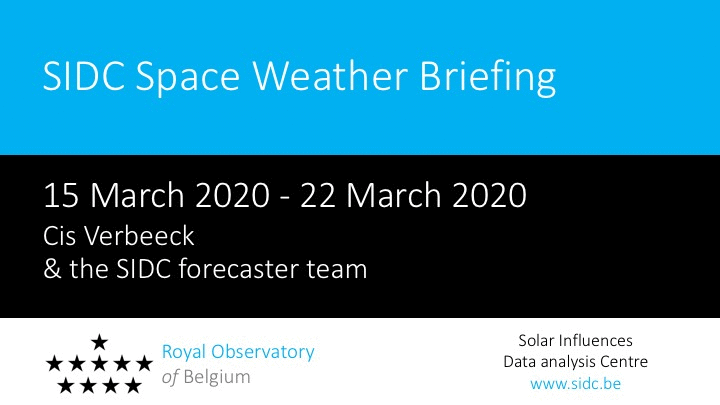
The pdf-version: http://www.stce.be/briefings/20200323_SWbriefing.pdf
The automatically running presentation: http://www.stce.be/briefings/20200323_SWbriefing.ppsm
PROBA2 Observations (16 Mar 2020 - 22 Mar 2020)
Solar Activity
Solar flare activity was very low during the week.
In order to view the activity of this week in more detail, we suggest to go to the following website from which all the daily (normal and difference) movies can be accessed: https://proba2.oma.be/ssa
This page also lists the recorded flaring events.
A weekly overview movie can be found here (SWAP week 521). http://proba2.oma.be/swap/data/mpg/movies/weekly_movies/weekly_movie_2020_03_16.mp4
Details about some of this week's events can be found further below.
If any of the linked movies are unavailable they can be found in the P2SC movie repository here https://proba2.oma.be/swap/data/mpg/movies/
Tuesday Mar 17
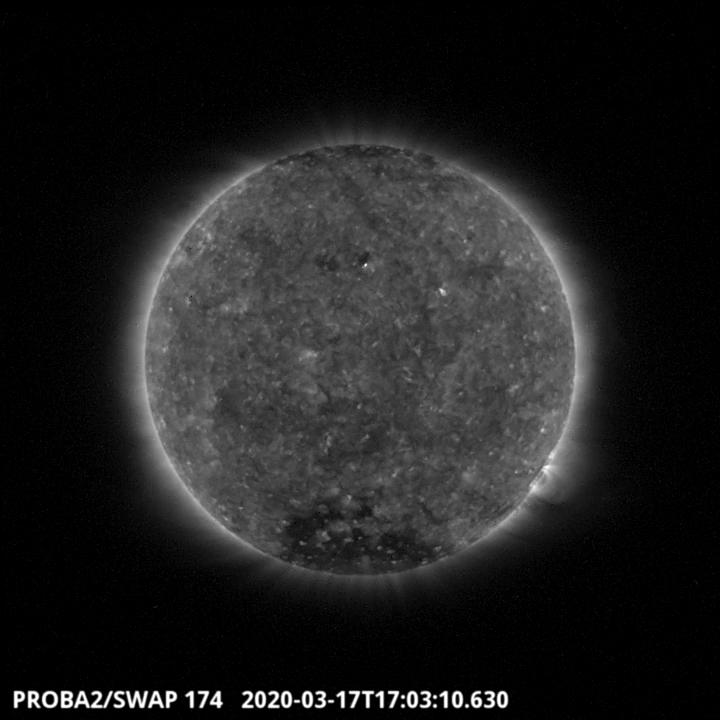
A small Flow in the Northern Hemisphere is visible on the SWAP image above around 17:03 UT.
Find a movie of the events here (SWAP movie) http://proba2.oma.be/swap/data/mpg/movies/20200317_swap_movie.mp4
The International Sunspot Number by SILSO
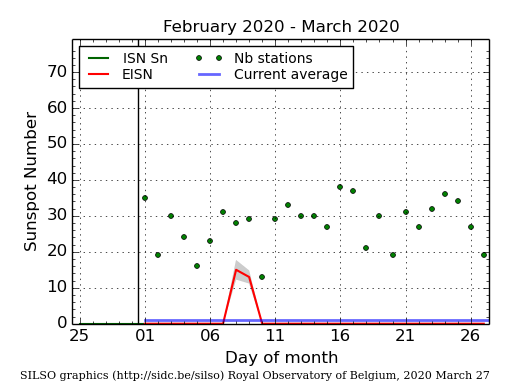
The daily Estimated International Sunspot Number (EISN, red curve with shaded error) derived by a simplified method from real-time data from the worldwide SILSO network. It extends the official Sunspot Number from the full processing of the preceding month (green line). The plot shows the last 30 days (about one solar rotation). The horizontal blue line shows the current monthly average, while the green dots give the number of stations included in the calculation of the EISN for each day.
Review of ionospheric activity (16 Mar 2020 - 22 Mar 2020)
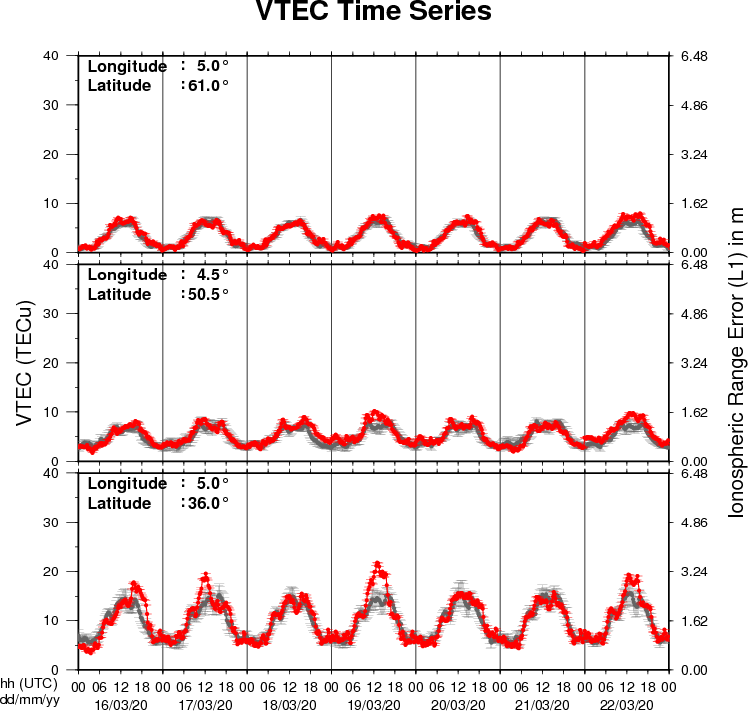
The figure shows the time evolution of the Vertical Total Electron Content (VTEC) (in red) during the last week at three locations:
a) in the northern part of Europe(N61°, 5°E)
b) above Brussels(N50.5°, 4.5°E)
c) in the southern part of Europe(N36°, 5°E)
This figure also shows (in grey) the normal ionospheric behaviour expected based on the median VTEC from the 15 previous days.
The VTEC is expressed in TECu (with TECu=10^16 electrons per square meter) and is directly related to the signal propagation delay due to the ionosphere (in figure: delay on GPS L1 frequency).
The Sun's radiation ionizes the Earth's upper atmosphere, the ionosphere, located from about 60km to 1000km above the Earth's surface.The ionization process in the ionosphere produces ions and free electrons. These electrons perturb the propagation of the GNSS (Global Navigation Satellite System) signals by inducing a so-called ionospheric delay.
See http://stce.be/newsletter/GNSS_final.pdf for some more explanations ; for detailed information, see http://gnss.be/ionosphere_tutorial.php
